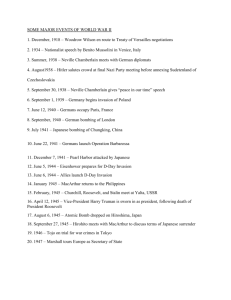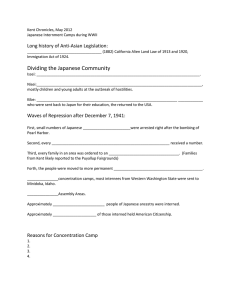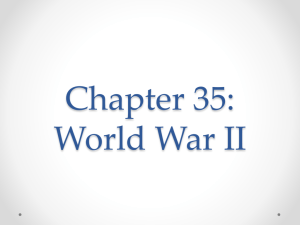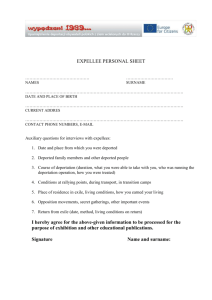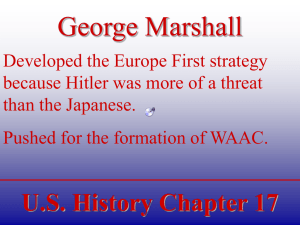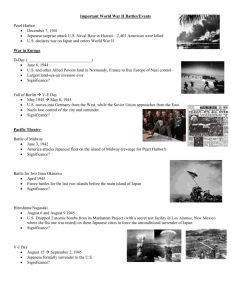Document 11995842
advertisement
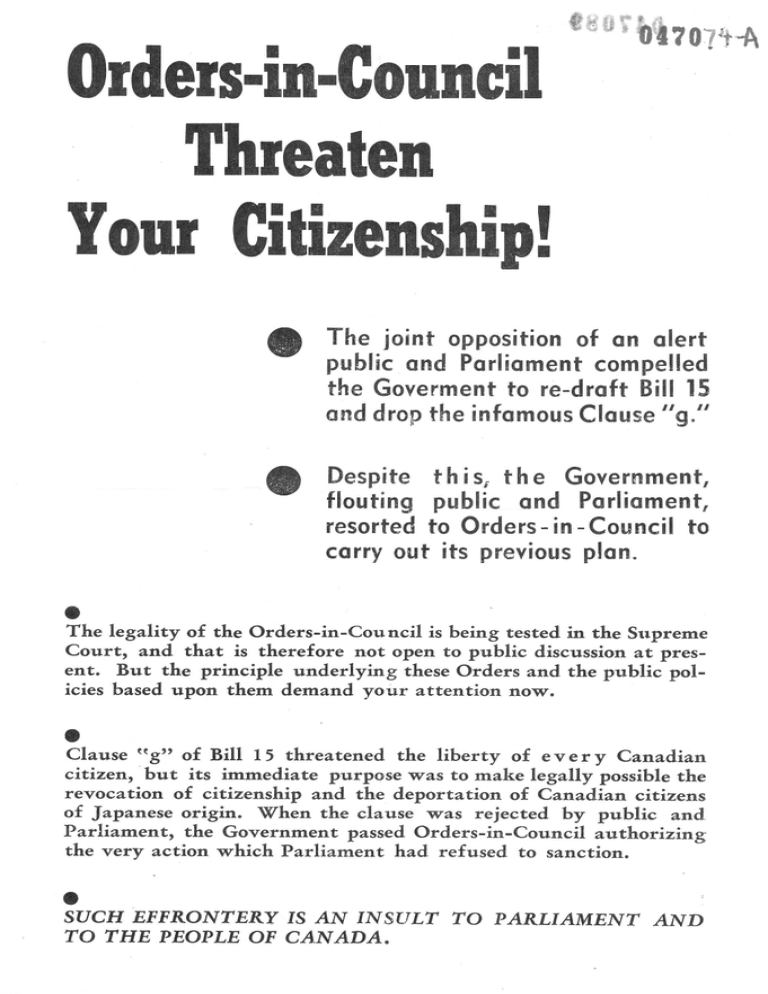
Order-in-Council re Deportation of Japanese P.C. 7355 The preamble to this Order provokes comment. Why were the "repatriation" forms signed? From a number of statutory declarations is selected a typical one which reads: "Whereas during the coursc of the war with "Tashme, B.C., ~/JCII, Japan certain Japanese natioilals ~~za~zrfested November 14, 1945. "I, Kameo Kumano, do hereby submit the s3'm&ath~ w i f h 0' s"PP0" o f ]'!'an by malcing rcfollowing statement: I was willing to go east but my wife is confined ~n the New Denver quests for repatriation t o Japan and otherwise; Sanatorium and a t that time I was told to go "And whereas other persons of the Japanese racc :d ::::: ~ ~ ~ k n ~ o ~ e f ~ ~ ~ o o ~ fused to sign a t first but Placement Officer Iar. have requested or may request that they be sent to E. F. Roberts threatened to cut me off t h e Department of Labor, Japanese Division, Payroll Japan; and also refused to give me maintenance. With no other alternative I had to sign for repatriawhereas it is deemed desirable that tion. sions be made t o deport the classes of persons re"This statement is given voluntarily and is true to the best of my knowledge and belief. ferred t o above; (Signed) "K. Kumano:" I t begins: ttzr .::;: "rind whereas i t is considered necessary by yeason of the war, for the security, defence, peace, order and welfare of Canada, that provision be made accordingly. . ." . This Order and t h e other two which follow were dated "December 1945"-m0re than four months after VJ-Day. The War Measures ~ c itself t expired on December 31, 1945. Following the preamble, are the operative terms of the Order. It lists those categories of persons who can be sent to Japan: ( 1 ) Every person 1 6 years of age or over, other than a Canadian national, who is a national of Japan resident i n Canada and who, since December 8, 1941, has made a request for repatriation or who has been interned for any reason since the beginning of the war with Japan. ( 2 ) Every naturalized Japanese, 16 years or over, living i n Canada who has requested repatriation: provided that he bas n o t revoked his reqztest in zuriti~zg prior t o midnight of Septelnber 1 , 1945. ( 3 ) Every Canadian-born peryon of Japanese origin, 16 years or over who has requested "repatriation": provided t h a t he has not revoked in writing such request prior t o the ?vnRing bji the Hundreds of persons of various obher nationalities have been interned in Canada during the war. None, as far as we know, have been deported because of being interned, nor has the government proposed to deport them. Speaking i n Parliament on December 17, 1945, t h e day the three Orders were tabled, Prime 1VIinister King said: "The circumstances of war and t h e peculiar character of the present problem require more expeditious and broader action than the present statutes allow. (Naturalization and Immigration Acts). But t h e Orders that have been passed to permit effective action raise no new principles, nor do they depart f r ~ many established principles." Minisfer of an order for deportation. ( 4 ) "The wife 2nd children under 1 6 years of age of any person for whom the Minister makes an for deportation to J~~~~may be included in such order and deported with such person." or.er Under what Canadian or established principle of law can the government deport to a foreign country the wife and Canadianborn children of a person, for no other reason than that they a r e his wife and children? The remainder of the Order sets out in considerable detail the powers and duties of the Minister of Labor, in carrying out the deportations. In contrast one recalls Prime Minister King's speech in the House of Commons on August 4, 1944, and particularly this sentence: "We must not permit in Canada the hateful doctrine of racialism which is the basis of the Nazi system everywhere." These three Orders-in-Council are based solely on racial considerations. Order-in-Council Revo king Na tu roliza tion P.C. 7356 The purpose of this Order is to revoke the citizenship of all persons deported under the previous Order. After a preamble of similar import to that of P.C. 7355, Sec. 1 reads:

